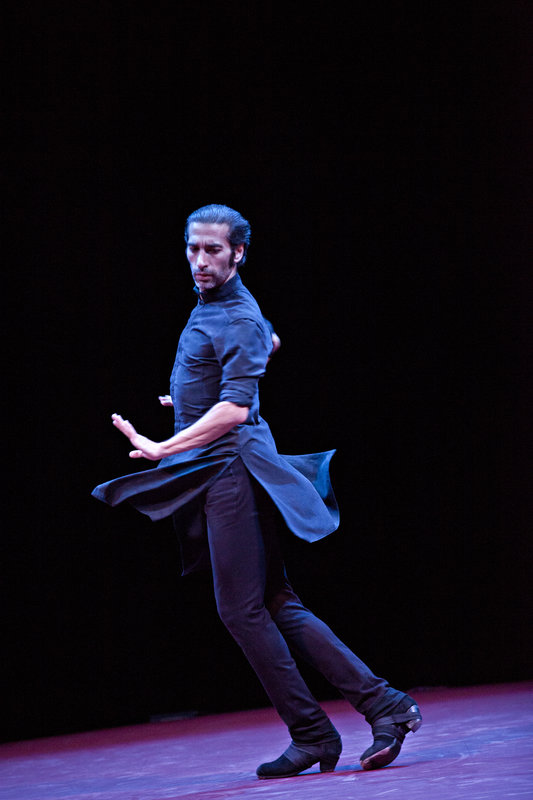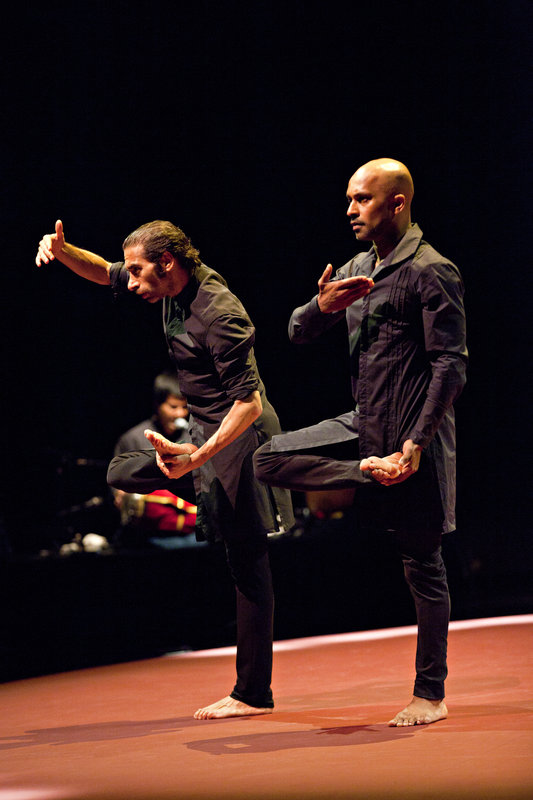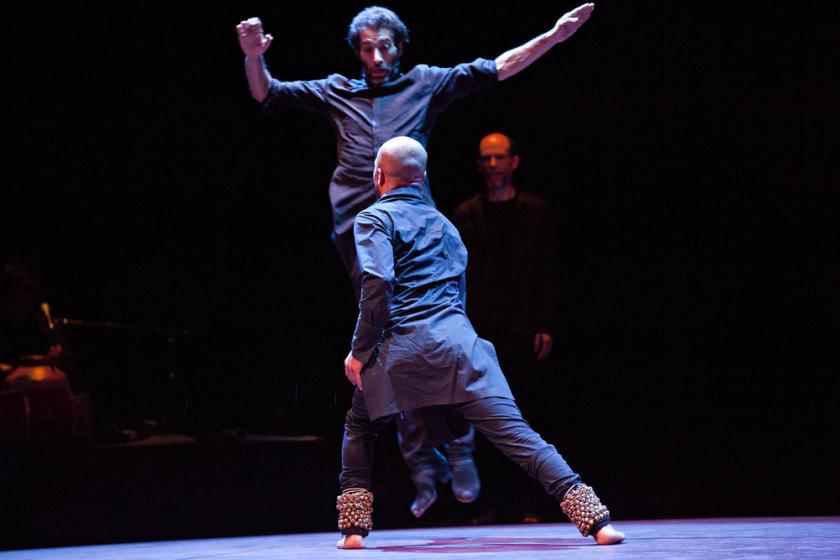When you're talking about dancers, the old adage about genius being 99% perspiration has a point. You have to work damned hard just to be average in professional dance; to be good, like Akram Khan and Israel Galván are good, takes sweat (and tears and blood, like as not). Still, all the perspiration in the world won't avail if you don't have that 1% of inspiration, a little blue flame of a pilot light in your soul, ready to spark the gas jets of hard work into fiery life, rather than just a lot of hot air.
This show works because Khan and Galván are inspired. The premise is pretty simple: let's see what happens when two great and original dancers, each a master in his own way of a classic dance form (Kathak and flamenco), get together and exchange ideas. So we see them dancing both together and apart: Galván first baring his feet like Khan, then Khan adopting shoes like Galván (though not on his feet!), each doing a sequence taught them by the other from his own tradition.
 They play with antagonism, lightly making out that they are competing with each other by pretending to intimidate or shut the other up, but they don't really try to hide their affection in the sections that they dance together. It's this encounter between Khan and Galván which has been the focus of much of the pre-publicity, and it's clearly integral to the whole construction and feel of the show, but there are also long sections in which both dancers and musicians fly solo, and in fact one of the real wow moments is Galván's moment in the spotlight (pictured above right), which is not obviously influenced by Kathak - although he's so wild, one can't really tell.
They play with antagonism, lightly making out that they are competing with each other by pretending to intimidate or shut the other up, but they don't really try to hide their affection in the sections that they dance together. It's this encounter between Khan and Galván which has been the focus of much of the pre-publicity, and it's clearly integral to the whole construction and feel of the show, but there are also long sections in which both dancers and musicians fly solo, and in fact one of the real wow moments is Galván's moment in the spotlight (pictured above right), which is not obviously influenced by Kathak - although he's so wild, one can't really tell.
Galván has the kind of lanky, loose-limbed frame that is almost intrinsically comic (viz: John Cleese) and he uses those long, pipe-cleaner legs to astonishing effect, tripping on his toes like a ballerina, jumping clean off the floor, ending a sequence by freezing with one knee somewhere near his armpit, as if pulled up there by an invisible string. Like John Travolta (whose Pulp Fiction incarnation he slightly resembles), there's a wiggle in Galván's hips; indeed, his whole body has the capacity to be anarchically off-balance, a maelstrom of tics and vibrations. It has been written several times that Galván's brain is wired differently, and indeed watching him improvise you can imagine him the creation of some steampunk scientist, electrodes wired to his skull and shivers of lightning travelling through his limbs. Khan has said that his own instinct is to find balance in everything and Galván's is to find chaos, and that's more than apparent in the contrast between their dancing styles (pictured left). Khan seems to have a reservoir of stillness inside him, and even his most intense bouts of stamping and whirling always build from that calmness; there is a meditative or trance-like quality to Khan when he's on a roll. Galván, on the other hand, seems to be going in every which direction at once: a live-wire twitching and scattering showers of sparks. Khan's solo pays more obvious tribute to flamenco, both playing with the staccato sound of booted feet, and channelling the extra physical tension of flamenco. (You hear the difference really clearly when both are barefoot: Khan's feet make a soft slap, as if relaxed and flexible, while Galván's thud tautly, a shorter sharper sound).
Khan has said that his own instinct is to find balance in everything and Galván's is to find chaos, and that's more than apparent in the contrast between their dancing styles (pictured left). Khan seems to have a reservoir of stillness inside him, and even his most intense bouts of stamping and whirling always build from that calmness; there is a meditative or trance-like quality to Khan when he's on a roll. Galván, on the other hand, seems to be going in every which direction at once: a live-wire twitching and scattering showers of sparks. Khan's solo pays more obvious tribute to flamenco, both playing with the staccato sound of booted feet, and channelling the extra physical tension of flamenco. (You hear the difference really clearly when both are barefoot: Khan's feet make a soft slap, as if relaxed and flexible, while Galván's thud tautly, a shorter sharper sound).
It all takes place in and around a great white circle: the dancefloor as drum, the stage as sounding board, which is appropriate since so much of this Kathak-flamenco exchange centres on the rhythmic virtuosity common to both forms. Lighting by dance-world great Michael Hulls picks out dancers and musicians in varying shades of burnt umber or cool blue, pools of light amid deep darkness - which adds to the trance-like feel: this is a show you have to let wash over you, rather than trying to analyse or ask questions of.
Kathak and flamenco share the characteristic of being music-and-dance, not just dance, and so the musicians on stage are as important as the dancers. Here, too there is a fusion of Spanish and Indian - I loved percussionist BC Manjunath using Spanish numbers as a "bol" (a kind of rhythmic mnemonic in Kathak). There's some serious charisma too: one of the most delightful moments in the whole show is when the musicians come forward from their seats behind the drum ring and do a little sing-and-dance-off of their own, the stunningly charismatic Christine Leboutte singing tenor at David Azurza (who later sings countertenor; it's all mixed up here), Bobote dancing and setting up rhythms, and BC Manjunath stroking gentle but insistent beats from a little hand-drum.
It feels a while since I last saw the Wells audience go so wild for a show, whooping and screaming at near fangirl pitch. I'd wager that the ecstasy wasn't universally shared - to get really bitten and drawn in by a show like this, you have to be in the right mood, or on the right wavelength, and if you're not, it will drag. Fans of Akram Khan, too, might have preferred to see a bit more of him. But even those who weren't thrilled must have been impressed: in whatever proportion the inspiration and perspiration were combined, there's no doubting the genius of all these performers.
- TOROBAKA is at Sadler's Wells until Saturday 8 November.
- Akram Khan returns to the Wells 25-29 November to perform Sacred Monsters, his acclaimed show with ballerina Sylvie Guillem.
- Watch a documentary about the making of TOROBAKA here.














Add comment